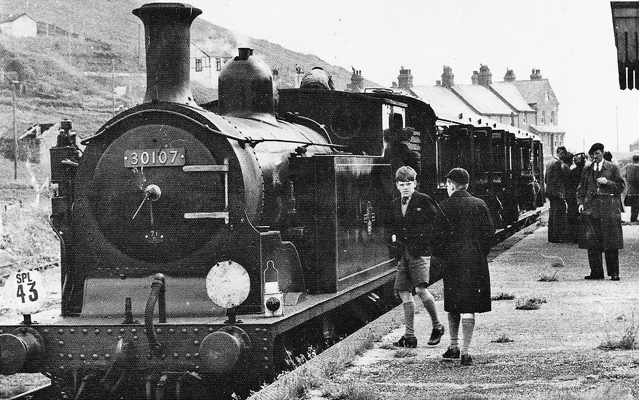West Bay Discovery’s new exhibition ‘Down The Track’ features the story of the railway line that ran from Bridport to West Bay. This year marks the 90th Anniversary of the closure of the passenger service that ran for 46 years. The freight service continued to 1965 when the lines were finally taken up.
There are still reminders of the railway line in West Bay. The station building, despite years of neglect and many other uses is restored, and along with the accompanying train carriage is now the popular Station Kitchen restaurant. The route of part of the railway line is now an attractive cycle track and footpath to Bridport.
The Victorian era was a period of development and there was a great enthusiasm for building railways. There were many options for connecting Bridport to the railway line but when none materialised a group of Bridport Businessmen set up the Bridport Rail Company and the first train ran down the line from Maiden Newton in 1857.
Plans for the West Bay Extension
It wasn’t long before local businessmen saw benefits in extending the line from Bridport to West Bay, then known as Bridport Harbour. A railway offered the prospect of transporting goods, such as sand and gravel quickly and would also support their plans to redevelop the harbour as a seaside resort
So on the 21st July 1879 the Bridport Railway Act enabled the Bridport Railway Company to construct a two-mile extension from Bridport to Bridport Harbour and work started in February 1883. The decision was taken that the station should be named West Bay – a name thought to be more attractive to visitors. At the same time plans were made for the erection of an esplanade and sea wall on the west side of the harbour along with modern residences. This scheme started with the building of Pier Terrace.
The West Bay railway station itself was an unusual design with passengers only being able to access the building from the platform side. The letters BR on the building denote Bridport Railways. The canopy originally stretched over the whole width of the platform (there is currently a model of the station on display at West Bay Discovery Centre).
Work on the line suffered delays, including a navvy’s strike over wages, which were around 2s 6d a day, and a flood. However, following an inspection the line was finally judged to be of “suitable construction and stability” and opening was planned for Monday 31st March 1884.
Opening Day
Opening day saw a carnival atmosphere in Bridport, a great number of passengers travelled down on the first train to West Bay at 7.32am. Overall, 5,100 first day tickets were issued, including 1,100 very excitable Sunday school children who were each given a bun and an orange. The children were however bitterly disappointed that due to the wet weather they were not allowed out of the train, which promptly returned to Bridport. There was grand public luncheon and later a band entertained the people in a field near the station. Obstacle races, bucket-of-water races and climbing the greasy pole were well contested and confectionery vendors set up nearby. Ships in the harbour were bedecked with flags and evening bonfires were lit on the cliffs. With a final cost of £23,000, the West Bay line was up and running.
The passenger service operated with five trains down to West Bay and back each day. Reports suggest that passenger numbers did not meet up to expectations. In 1916 with many staff enlisted in the Great War, the line temporarily closed to passengers. The freight business was still very busy with millions of hemp lanyards produced in Bridport being used by the services along with hay nets for Army horses, ropes and camouflage nets and twine.
The decline of the branch line
In 1919 the line reopened but now it faced serious competition from the new motor buses that were able to run between Bridport and West Bay without having to start or finish at a station.
In the years that followed it also became clear that West Bay would not become a tourist resort to rival the likes of Bournemouth and Weymouth. All there was to show for the previous grandiose plans was the building of a few houses and other buildings to service the holiday trade.
Despite assurances to the contrary, on Monday 22nd September 1930 the passenger train service between Bridport and West Bay was quietly withdrawn. The freight service continued, the Second World War bringing extra business. Shingle was taken from the beach at West Bay for use in airfield construction and train loads of nets were dispatched to the military.
Eventually only one train a week ran, and the West Bay line was finally closed to freight traffic on 3rd December 1962 and in 1965 the rails were finally removed.
The West Bay Discovery Centre’s exhibition highlights stories of the Bridport to West Bay line and those who worked on it. Railway historian Professor Colin Divall has acted as the Centre’s advisor on the exhibition along with Gerry Beale author of The Bridport Branch who has loaned some amazing photos and other material. Brian Jackson, joint author of another book on the Bridport branch has also supported us. The Bridport Museum have kindly loaned artefacts for the exhibition. Wild and Homeless Books in Bridport can supply copies of The Bridport Branch along with a wide selection of other railway books.










